Final report for FNC16-1042
Project Information
This project was implemented on two tracts of land, one tract was 80 acres on the White Earth Indian Reservation and the second was on 40 acres adjacent to Mille Lacs Indian Reservation. The project was started in 2016 and consisted of growing 10 traditional Anishinaabe foods on plots within these tracts of land. The grant was the start of this effort to grow some varieties of traditional food and there has been an on going 15-year effort to grow traditional heritage foods of corn and beans. The overall goal was to use traditional Anishinaabe foods to produce a sustainable food product that could be eaten or sold locally.
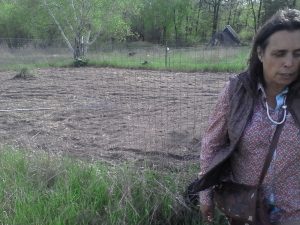
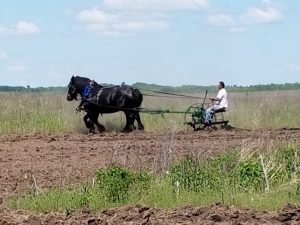 Brain working the field with horses (2017)
Brain working the field with horses (2017)
WORK ACTIVITIES
GOAL: Our goal was to re-establish perennial and annual Indigenous varieties of food for consumption by our community and by gourmet Indigenous chefs on two farms – one in Mille Lacs reservation territory and one on White Earth reservation.
In the spring of 2016 we planted two farm plots with the following plants:
- Jerusalem Artichokes (perennial) - A’skibwan’;
- Purple heritage potato - opin or bawajipin;
- Heritage beans: Cherokee Trail of Tears heritage black beans and Hidatsa Shield beans, Taos Red Beans varieties - mushkodiisimin;
- Mandan and Gete okosomia Heritage Squash - na’bdwogwis’simadin;
- Heritage blue corn varieties for hominy and flour corn, and black popcorn – mandaamin;
- Bergamot, Milkweed and pollinator habitat– bibi’gwunukuk’ wabino’wuck;
- ini’niwunj’ Hog peanuts – bugwudj’miskodi’simin
- Juneberries and Chokecherries – guzigwa’kominaga’wunj;
- a’sisuwe’minaga’wunj Flowers - waabigwan
One species that was not planted was Hog peanuts – bugwudj’miskodi’simin. These will be planted in 2017.
The project utilized traditional agriculture and tried reduced petroleum agriculture processes to care for and produce these heritage foods including fish fertilizer, inter-cropping, and limited tractor equipment.
This project is part of a three-year project to create the basis for organic certified gourmet Indigenous crop varieties, and to determine the possibility of creating a tribal organic/fair trade certification program.
The project worked on a teaching field for the benefit of tribal school children on the White Earth reservation. It also did a presentation on the Mille Lacs Reservation.
The project tried to create a product for a gourmet indigenous chief in the region.
RESULTS
The project began with renting land, preparing the plots, and planting species outlined in the project. The project got germination on all plant species. The plants were fertilized with fish emulsion and observations were made on effects on the various plants. The beans and corn showed improvement with the added fertilization while the squash did not – in some cases it killed the plant.
During summer, heavy rains drowned out potatoes and washed out many of the flowers.
The project had significant problems with deer. The deer ate most of the newly germinated corn and ate all the heritage corn plants and left non-heritage corn plants. The deer also ate the squash in August.
The Bean project was the most successful of varieties that were grown. The Bean project consisted of growing three varieties of heritage beans: Cherokee Trail of Tears Black Bean, Hidatsa Shield Beans, and Taos Red Bean. The beans were planted in rows. The Black beans and Shield beans are climbing beans and string was used to create a measure for climbing. The rows were cultivated to keep weeds down and no herbicides or insecticides were applied. Fish fertilizer was used to enhance production; no commercial fertilizers were applied to the soil. The beans were planted in the third week of May with germination in four to seven days. We observed that the black beans produced more beans per linear feet of row. The rows were 40 inches apart. The beans were all harvested in mid-September.
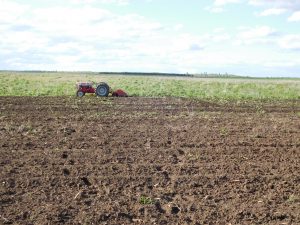 Ground being prepared Becker County (May 2016)
Ground being prepared Becker County (May 2016)
|
Bean type |
density |
rows |
production/acre |
cost/acre |
gross sale |
profit |
|
Cherokee Trial of Tear Black Beans |
4 inches |
40 inches |
815 lbs. |
$1,938.75 |
$4,881.85 |
$2,943.10 |
|
Hidasta Shield Beans |
4 inches |
40 inches |
653.4 lbs |
$1,938.75 |
$3,913.87 |
$1,975.12 |
|
Taos Red Beans |
4 inches |
40 inches |
544.5 lbs |
$1,938.75 |
$3,261.56 |
$1,322.81
|
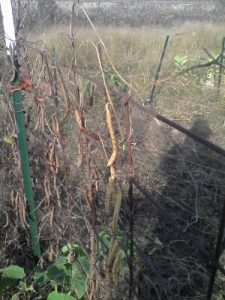 Black beans Crow Wing (Fall 2016)
Black beans Crow Wing (Fall 2016)
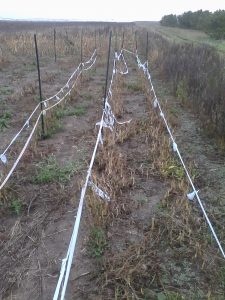 Red Beans Becker County (Fall 2016)
Red Beans Becker County (Fall 2016)
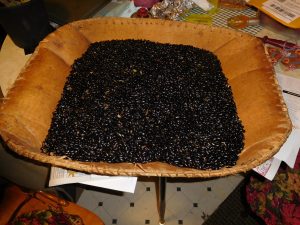 Cherokee Trail of Tears Black Beans harvested (October 2016)
Cherokee Trail of Tears Black Beans harvested (October 2016)
Potatoes: The heritage purple potatoes were planted the second week of May on both plots. The plots that were used became flooded when heavy rains in August (6-, 8-, and 10-inch rains). The standing water killed the potatoes and very limited potatoes were recovered.
Jerusalem Artichokes: The Jerusalem artichokes were planted on higher ground and the heavy rains did not affect them. The plot in Crow Wing County was eaten by deer in late August and early September. The deer ate the flowers first and then the leaves off the stalks. At the Becker County plot, the deer did not eat the Jerusalem artichokes and the plants produced big tubers. Every other plant was harvested and some 40 pounds of artichokes were harvested off of that plot. The second year observations will be made to determine the spread of the Jerusalem artichokes and a measure of production levels.
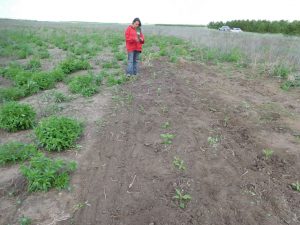 Winona and Jerusalem artichokes coming up (end of May 2016) Becker County
Winona and Jerusalem artichokes coming up (end of May 2016) Becker County
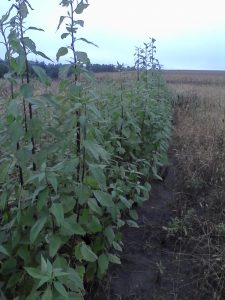 Jerusalem artichokes Becker County (Fall 2016)
Jerusalem artichokes Becker County (Fall 2016)
Squash; Mandan and Gete okosomia Heritage. These two squash varieties were planted the 4th week of May. There was good germination. With the application of the fish fertilizer about half of the plants died and the others were also set back. It was unclear of the cause of this. Was the mixture too rich or did these plants not like this type of fertilizer? The result was that there was very limited production and what was produced was very small. When they ripened in September the deer ate part or all of them.
Corn; blue corn varieties for hominy and a pink flour corn. These species were all planted in both areas the first week of June. The germination was good in both areas. The plants were about 3 days old in the Crow Wing plot when the deer ate them. There was one plot that was fenced and this pink corn was not eaten by the deer. The corn in the Becker County plot did not have this early problem with deer. The Crow Wing corn plots were replanted the second week of June and again the deer ate the new plants. The deer were selective in eating only the heritage plants. The corn in the fenced area and at the Becker plots continued to grow and mature. By mid-August the corn was putting on ears. The Crow Wing plot that was fenced had stalks 6 feet high with ears on most stalks. In September the raccoons came through and ate most of the crop. At the Becker County plots a black bear came through and ate both plots of corn growing there.
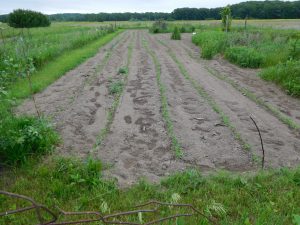 Corn fenced area (June 2016)
Corn fenced area (June 2016)
Black popcorn; A plot of black popcorn was planted in the Becker County field. The bear that ate the corn seem not to like the popcorn leaving that plot alone. It did break down the stalks. Some popcorn was harvested.
Bergamot, Milkweed and pollinator habitat: The Bergamot was planted both inside and by sowing the seeds outside. There was good germination with the seeds planted in flats but poor germination with seeds planted directly in the soil. The seeds are very small and it is believed that they are easily destroyed by rain or wind. The seeds that were germinated in flats grew well and at about 1 inch in height they were transplanted into a tilled plot. A heavy rain directly after planting drowned out many of the transplants. Some of the plants survived and grew throughout the summer. Observations will be made to determine winter survival. Milkweed seeds were planted and production was good. Milkweed was able to grow well in the different weather events.
Hog peanuts: Did not obtain seed and was not planted.
Juneberries and Chokecherries: 75 Juneberries trees were planted and 50 Chokecherries were planted. The trees were divided and planted on both Crow Wind and Becker County plots. There was no observed loss to these trees.
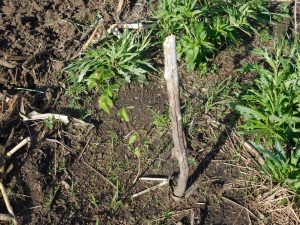 Juneberries tree Crow Wing (May 2016)
Juneberries tree Crow Wing (May 2016)
Flowers: Five varieties of sunflowers and other flower were planted on the various plots with good success.
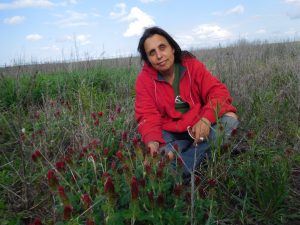 Winona in some cover crops planted (May 2016)
Winona in some cover crops planted (May 2016)
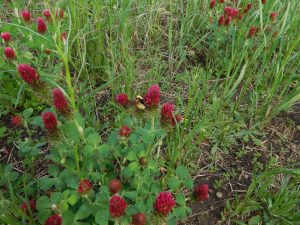 Bumble Bee enjoying the Crimson Clover flowers (May 2016)
Bumble Bee enjoying the Crimson Clover flowers (May 2016)
WORK PLAN FOR 2017
In the 2017 growing season the project will continue with planting and growing traditional Anishinabe plants. The perennials will be expanded and there will be continued monitoring of the perennials planted in 2016. Hog peanuts will be planted this year. There will be an effort to fence the plots to reduce impacts from deer and other wildlife species. A draft ordinance will be completed related to tribal organic certification program. The project will continue to plant annual plants and measure the perennials’ progress.
OUTREACH
The information about the project was presented both at the White Earth Reservation and Mille Lacs Reservation. This included getting the Mille Lacs Reservation to develop a program in developing agricultural activities. There were 6 community meetings conducted at Mille Lacs with a total of about 300 people attending. Two community hearings were held at White Earth Reservation in Ponsford and discussion with about 100 people. The field trips where conducted in August and about 15 people attended. The project will continue to provide information to the tribal communities.
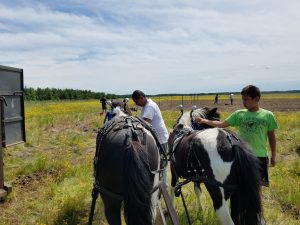 Ponies were used to plow and plant corn (2017)
Ponies were used to plow and plant corn (2017)
Cooperators
- (Educator and Researcher)
- (Educator)
Research
The project looked at how to provide sustainable farming activities by growing Anishinaabe traditional foods with an emphasis on restoration of heritage seeds used by the Anishinaabe and introduce these product in local market consumption. We found that production levels were good when there was adequate protection from wildlife since deer and other animals preferred the heritage plants over the commercialize plants in the general area. This protection was done mainly through fencing.
The main measurement was that in 2016 most of the corn crop was eaten by wildlife with a very limited harvest. In
2017 after fencing was installed a significant amount of corn and beans were harvest.
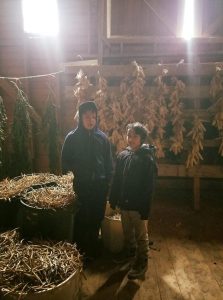
Educational & Outreach Activities
Participation Summary:
The project had an educational events with Breck School in Minneapolis. The 15 students spent the day May 28, 2017 in field preparing the soil and planting. Over the summer 2 to 3 people would stop and observe or help the weeding and caring for the plants. In November 2017 at the Pine Point Elementary School on the White Earth Reservation the students participated in shelling corn and beans (see attached pictures)
The project officer contacted the Breck School and Pine Point School to work out farm visitations and school presentation.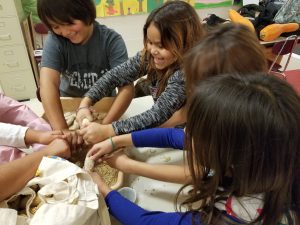
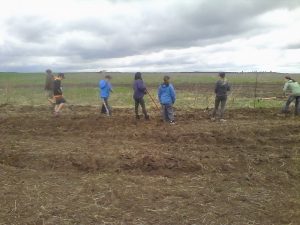
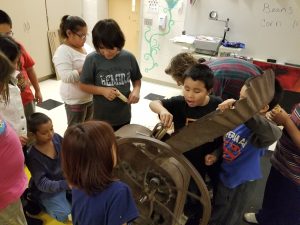
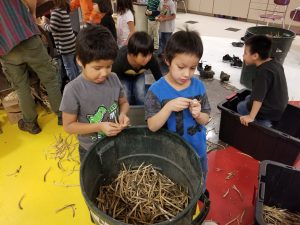
Learning Outcomes
The project was successful in that it completed the process of growing traditional foods listed. The biggest barrier was impact from wildlife. The first year deer impacted many of the plants that were grown. The second year there was constructed 7.5 foot high fences around fields that were planted. This was done on both fields: the one in Becker County and the one in Crow Wing County. The second year there was an improvement in production and there was not impact from deer. Though in the Crow Wing parcel, rabbits and woodchucks were able to cut hole through the fence because it was webbing. The Becker County parcel was fenced with wire fencing and this prevented rabbits from being a problem. The webbing type of fencing worked well to keep deer out; rabbits were able to eat holes through it. The cost of the webbing was a little less that the wire fencing but the wire fencing worked better. A 3-foot-high wire fence was placed around smaller plot which prevented smaller animals from getting at the plants.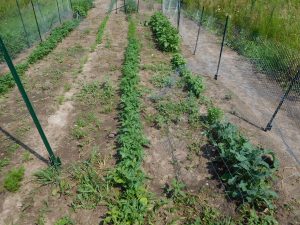
Project Outcomes
There were a number of benefits from growing traditional foods. The Pine Point Elementary School student had a great time shelling corn and beans. To get the children to think about growing their own food and growing traditional foods was an important outcome.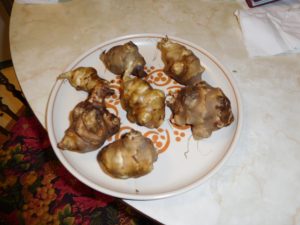
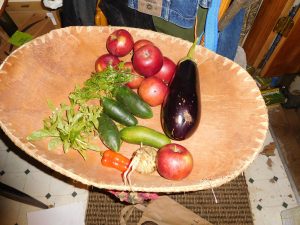
In 2017 the White Earth field produced a good harvest of Painted Mountain corn, Dakota White Flint corn, and popcorn. This was used in community feasts at Ponsford Elementary School and an event in Duluth sponsor by Honor the Earth and the food cook by the Sioux Chef.  (Beans, and Corn dry in the barn fall harvest 2017)
(Beans, and Corn dry in the barn fall harvest 2017)
One of the things identified that would be interesting is how long plants will reproduce and how they will produce without replanting. This does not work for plants like corn and beans, but berries, and artichokes can reproduce year after year.